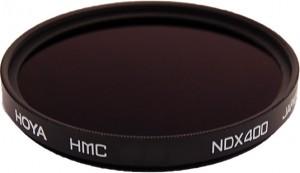Daylight long exposures with ND filters
Have a look at the photos below. They’re both taken at the same time and location – however, they both present the scene very differently.

The first is your typical location snap – taken hand held at a fairly fast shutter speed because there’s plenty of light (f14, ISO100, 1/40) . Motion is frozen (look at the ripples and waves on the surface of the lake). The second was taken with the use of a NDX400 filter (a 9-stop filter) and with the camera on a tripod. Motion is blurred – check out the streaking clouds in the sky, and the silky appearance of water (f14, ISO100, 13 seconds).
An ND (neutral density) filter works to reduce the amount of light entering the lens. It’s a piece of tinted glass (or plastic) that can be screwed onto the lens (or slid onto a filter holder in front of the lens) to control the amount of light entering the lens.
You can purchase ND filters that reduce specific amounts of light (called “stops”) entering the lens. An ND8 filter, for example, reduces 3 stops of light entering the lens. An ND400 filter, such as the one used to create the second image, reduces 9 stops of light entering the lens.
What’s a “stop”?
Essentially, a “stop” is a way of measuring exposure. Each stop affects exposure by a factor of two. So, if you reduce the amount of light entering the lens by 1 stop, then you’re halving the exposure. If you reduce it by 2 stops, you’re quartering it, and a 3 stop reduction means that only 1/8 of the light is entering the lens. Less light entering the lens means that you’ll need to leave your shutter open for longer in order to obtain a balanced exposure
Let’s look at the exposure of the first image, taken at f10, ISO 100. Given the lighting situation of the scene, the camera’s light meter suggested a shutter speed of 1/40 of a second in order to obtain a balanced exposure. If we had put a ND8 filter on the lens, thus reducing the amount of light entering by 3 stops (or only 1/8 of the light is entering the lens), then this would mean that we would need to slow the shutter speed to compensate for it.
How do you adjust the shutter speed to compensate for reduced light entering the lens?
It’s easy! Most DSLRs have, by default, exposure values set to a third (1/3) of a stop. What this means is that three clicks on the dial = 1 stop. For example, if I went from a shutter speed of 1/40 to 1/30, that would be increasing the exposure by 1/3 of a stop. Dropping it down from 1/40 to 1/25 increases the exposure by 2/3 of a stop. Going from 1/40 to 1/20 increases exposure by a whole stop.
If you’re not sure whether your DSLR has been set to 1/3 stops in terms of exposure value steps, refer to your manual as it will show you how to go about checking, and changing, this on your DSLR. Look in your manual’s index for the topic “EV steps for exposure control” or similar.
With an ND8 (three-stop) filter on the lens, I would need to increase the exposure by three whole stops to compensate for the reduction of light entering the lens. If I had a starting shutter speed of 1/40, this would take me down as follows:
1/40 (normal) -> 1/20 (1 stop) -> 1/10 (2 stops) -> 1/5 (3 stops).
However, a shutter speed of 1/5 isn’t going to be slow enough to create that nice, silky motion in the water, or to streak the clouds. What I need, then, is a much stronger ND filter – the NDX400 filter which reduces the amount of light entering by 9 stops!

As you can see from the image of the filter, its glass is very tinted. Put it on your lens, look through the viewfinder and you’ll barely be able to see anything!
I use a Hoya NDX400 filter when shooting in daylight. It’s a durable filter with great glass (thus ensuring image quality and sharpness). Once I screw the filter onto the lens, I reduce the amount of light entering by 9 stops. Enough for me to go from an exposure of 1/40 of a second without the filter, to 13 seconds with the filter.
How do I use ND filters?
I find it easiest to set everything up first prior to putting the filter on the lens. In shooting landscapes, I always use Manual Exposure as it allows me to fine tune the exposure to get the look I want.
- I first make sure my DSLR is set on Manual Exposure Mode.
- Then, I work out an exposure for the scene without the filter on.
- Next, I lock focus.
- Finally, I compose and frame the scene in the viewfinder (or if you have a DSLR with liveview, us that as it makes framing much easier).
Once done, remember to switch from Autofocus to Manual focus because you don’t want your camera to hunt for focus once you have out the filter on (chances are, there isn’t enough light entering the camera for its autofocus to work effectively). So: lock your focus first, flick the autofocus switch to Manual focus, and then put the filter on.
Then, you just need to work out the new shutter speed to compensate for the number of stops of light that the filter reduces. If your camera has its exposure values set to 1/3 of a stop, then it’s simply a case of counting downwards with each little click of the dial = 1/3 of a stop. Hence, three clicks = 1 stop.
Once you’ve set the new shutter speed, take the picture and check the results on playback (remember to use the histogram to confirm that the exposure of your image falls within your expected range).
That’s pretty much it!
Enjoy shooting long exposures in daylight!
NOTE: If you’re thinking of getting a 9 or 10 stop exposure, there’s a range of filters available. Remember, though, that you will get what you pay for and while some cheaper filters may seem appealing, they will not produce images as sharp as those you will get with better quality filters. I use and recommend Hoya filters. Ask your local photography retailer about this filter, or, if you have a bit more in your bank account, ask about the Lee Big Stopper, which reduces the amount of light entering the camera by a whopping 10 stops!
SIDE NOTE: It’s come to my attention that some local retailers will try and sell you variable ND filters. Avoid these like the plague as they can create image banding and unattractive vignetting, especially in cheaper brands.

Carl Perkins
03/12/2013 at 5:58 pmThank you.
Sue Hickton
06/03/2014 at 8:07 amthanks Seng – while I understood these in principle I do understand it a whole lot more now. I have been considering some ND filters for this kind of thing, and understanding it more will certainly assist!
Kerry Favazzi
01/04/2014 at 1:00 pmAwesome example. Ive done a photography but forgot about the use of filters!! Thanks for the excellent instruction on how to use the ND filter.
Chad
12/11/2021 at 3:46 amGreat Lesson….Thank you so much